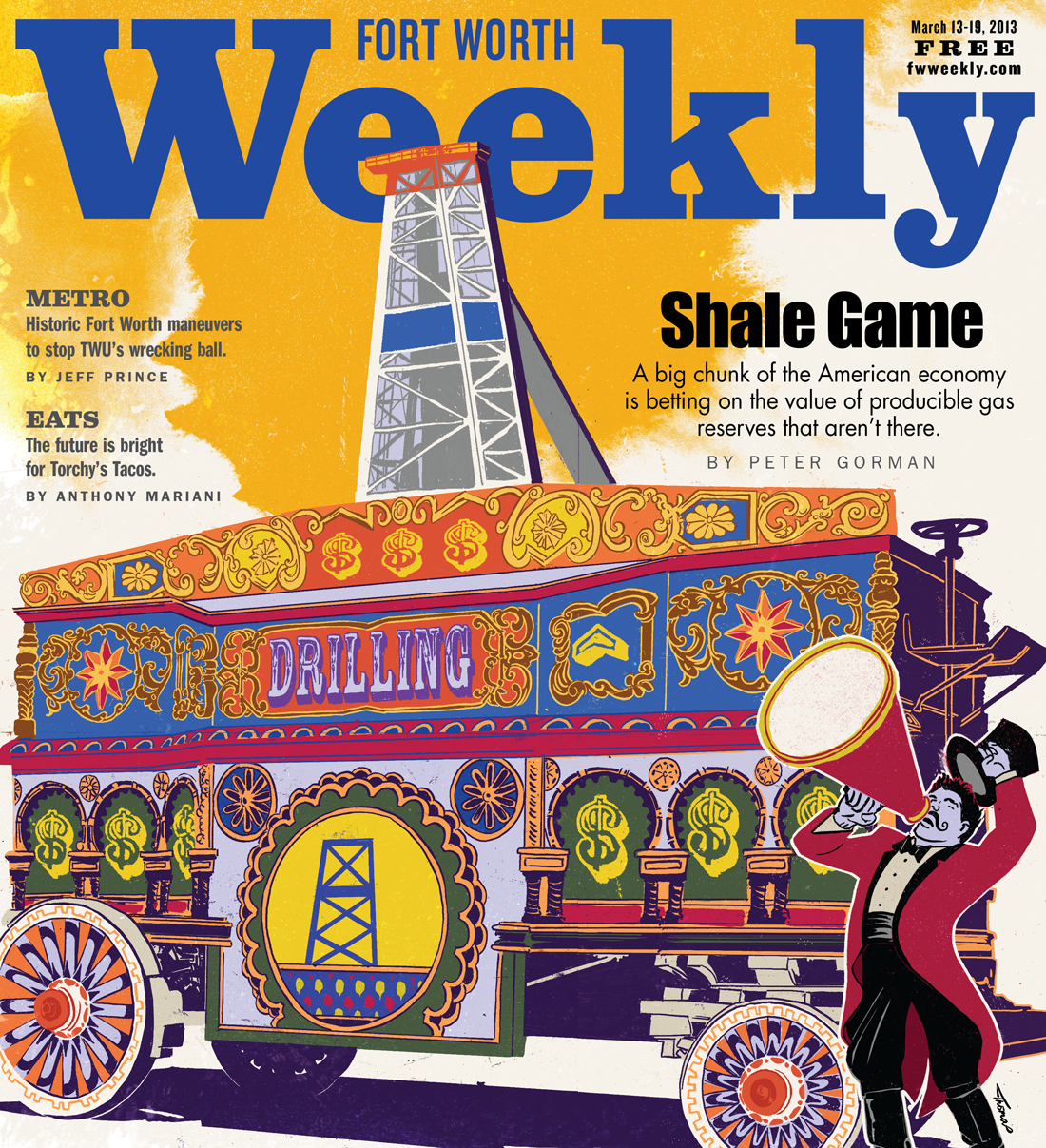The early days of the shale gas boom around Fort Worth were heady ones. Chesapeake tossed money around as if it were limitless. Need a new museum of science and history? They helped cover it. A sponsor for the annual Thanksgiving parade? Done. Chesapeake hired actor Tommy Lee Jones to plug the benefits of natural gas with tag lines like “Let’s get behind the Barnett Shale” and “It’s here for good.” The industry group, Natural Gas Alliance, claimed the gas was going to flow for 100 years.
But is it? Two new and significant papers related to the finances of gas drilling and natural gas suggest the natural gas boom will not be here for anything like that long. The vast reserves touted by Chesapeake and every other natural gas company, and echoed by state and federal government agencies, have turned out to have been either mostly hype or so inaccessible that they don’t count for practical purposes. In just a few years, the boom has nearly gone bust, and it is beginning to drag a lot of communities and investors down with it.
Why? First, according to the authors of the reports, because the reserves simply are not there. And secondly, because a push to extract as much gas as possible from each field as quickly as possible has produced a glut on the market, which has caused natural gas drilling to be unprofitable in all but the very best areas of the best shale fields.
The drop in price, however, encouraged a lot of industries, including power companies, to retrofit their plants for natural gas rather than coal or oil. And without an abundant supply of gas over the long haul, that may prove very costly for consumers once the surplus of cheap gas is gone. Add to that a new wrinkle that not many people saw coming — the exportation of natural gas to countries willing to pay a premium for it — and the cost of natural gas in the United States could increase tremendously in the next five to 10 years.
In a paper published in February, Deborah Rogers, a former member of a Federal Reserve Bank of Dallas’ advisory council, described how the early years of the shale boom led gas drillers to borrow wildly so that they could get wells in before their leases expired. That caused an excess of natural gas, which dropped the prices to record lows.
And then the sky really fell in: The wells, especially in “sweet spots” like the Fort Worth section of the Barnett Shale, saw declines in production that no one could have imagined.
But the banks that had lent all that money to the energy companies needed their loans repaid, so energy companies had to keep drilling new wells to maintain production volumes. It looked good on paper and kept stock prices at reasonable levels for a few years, but with a couple of exceptions, nearly all of the gas companies have seen their stocks nosedive in the last year.
In the second paper, also published in February, geologist David Hughes, who worked for the Canadian government for 32 years, breaks down how quickly the major shale plays in the United States are being depleted. Hughes draws the conclusion that many, if not most, shale gas wells in this country will run dry in 10 years or less –– leaving a lot of investors holding worthless stock.
It’s an ugly picture –– for drillers, investors, banks, and all the industries that are retooling to use cheap gas that may not be there.
“I think the big winners in the game have already bailed, and a lot of people down the food chain are going to get burned in a few years,” Hughes told Fort Worth Weekly.

Hughes figures that shale drillers probably believed their own hype when they first married the hydraulic fracturing process (which uses high-pressure liquids to crack open shale rock and release the natural gas trapped inside) with horizontal drilling in 2002 in the Barnett Shale. “Initially, the drillers were comparing these to conventional gas wells,” he said, in which production drops quickly after the first year but then remains relatively steady, declining slowly over many years.
But, Hughes said, it couldn’t have taken long for the drillers to realize that their wells would reach terminal decline much more quickly. “The rocks in shale drilling are so impermeable that when we crack them, the gas is released much more quickly. So these wells may last 10 years or only six or seven before they have to shut them down. They’re so new that we have no history to show they will last more than 10 years.”
That didn’t keep the drillers from touting “40- to 50-year wells.”
It makes business sense that if you are trying to get people to invest in your company, you use the most optimistic estimates and claim the wells are going to last decades — “but nobody knows that,” said Hughes, “and looking at the rate of decline in production, well, they’re not going to last very long at all.”
The decline Hughes is talking about is steep. In the shale plays that produce nearly 90 percent of all shale gas in the United States — the Haynesville Shale in East Texas and Northern Louisiana, the Barnett Shale in Tarrant and several surrounding counties, the Marcellus Shale, which stretches from Eastern Ohio through Pennsylvania and south to West Virginia, and the considerably smaller Fayetteville, Eagle Ford, and Woodford plays — the decline in production averages more than 85 percent in the first five years.
When the Haynesville Shale, discovered by Chesapeake founder Aubrey McClendon, began to produce in 2008, gas companies flocked to buy leases and drill. By 2010 there were 180 drilling rigs working the play, and by 2012 more than 2,500 wells were producing.
But optimism turned to pessimism quickly: The production from the wells dropped 68 percent by the end of the first year, and by the end of four years, the average well was producing at less than five percent of its initial level.
“What you have to remember when looking at a shale play is that drillers head for the sweet spots first, the places with the most accessible quantities of gas,” Hughes said. “When the first few wells come in, a leasing boom follows. But the majority of the wells drilled are not going to be in the sweet spots — maybe only 15 percent will be. So when we look at the drop in the Haynesville play, what we’re seeing is that if the sweet spots are drying up, drillers wind up going after less productive areas in the play. But with the cost of each new well in the Haynesville at about $9 million — and that doesn’t include the leasing rights or costs of pipelines and so forth — and the price of gas at $3.30 per thousand cubic feet, who in their right mind is going to keep drilling?”
He pointed out that the number of drilling rigs active in the Haynesville has dropped from a peak of 180 in 2010 to 20 this year. “In the life cycle of a gas field, the Haynesville, at four years old, is already in late middle age,” he said.
In the Barnett Shale, where the average drop in production is about 30 percent each year, Hughes said, “You need to drill 1,500 new wells every year, each of which has the same average first-year production of a 2011 well, to simply keep [total] production flat.”
And that’s not happening. Devon Energy, the largest developer of natural gas in the country and, along with Chesapeake, the largest developer of the Barnett Shale, has reduced its rig count in the Barnett Shale to just six this year, according to spokesperson Chip Minty.
Julie Wilson, Chesapeake’s vice-president of urban development, said the company currently has only two rigs in the Barnett Shale.
So why did the companies keep drilling those wells, continuing the overproduction that meant they were selling their precious reserves at bargain-basement prices?
“It started with the land leases,” Hughes said. “Those leases have to be drilled in three to five years, or you’ve lost your investment.”
********













So when they come back, we need to be ready with lock tight Gas Drilling Ordinances that are as protective to the public health as possible. Arlington has too many loopholes in their ordinance…I live, breathe, and blog in BarnettShaleHell.
Why do they keep poking holes to get hydrocarbons out of the ground then purposely vent massive amounts of those hydrocarbons into the air? see video at here http://www.texassharon.com/2013/03/09/emissions-video-marathon-sugarhorn-central-facility-in-eagle-ford-shale/
The latest research shows that viewed on a 20-year timeframe, methane is 105 X more potent as a GHG than CO2! When viewed on a 100-year timeframe, methane is 2 to 30 times more potent.
Bad reporting and not based on facts. It is well known that these wells will have to be fraced every seven years. Of course all the companies that have leased and drilled here are just doing it for the hell of it, to squander stockholder and operating cash. Hughes was debunked a long time ago, and Sharon is still trying to stay relevant after she got caught with her hands in the cookie jar with Al Armendariz, Mr. “let’s make an example out of them like the Romans did to the Christians”. Of course Sharon and Al never mention how they are going to power this brave new world, I suppose with wind driven sail vehicles and biofuels which are a farce and take food off the table for the world. But it did not stop Sharon from leasing her Wise County minerals. But she has to make a living working for Earthworks, so have at it.
Johnny Ringo: Calling something bad reporting without backing it up doesn’t amount to anything. Can you explain why Hughes’ stats do not hold up and can you explain where Ms. Sharon Wilson and Mr Armandarez got caught with their hands in the cookie jar? And where does Mr. Rogers report fit into this, as you fail to mention it. I think you need to do that , and do it with real facts, before you can make those accusations. And, as I’m sure you know, when people were asked to lease their lands, they were told the story of energy independence for the USA and mailbox money and how it would help us all. A lot of us fell sucker to that, and a lot of us learned the hard way that if 73 percent of the people in a lot signed on, then we were included whether we signed on or not–in which case it didn’t make sense to ignore the upfront payment, regardless of political bent, unless we were already wealthy. So far, your argument doesn’t hold water because there is no substance.
I look forward to what you will produce.
so what the heck, 10 yrs life isnt so bad afterall.
(assuming the anti’s are correct).;
Pete – you don’t keep up with current events do you like your story is rehashed info from 4 years ago and Armendariz was forced to resign from after all his Fubars. And Wilson of course did lease her minerals for gas exploration which do you not find hypocritical? I suppose like with most ultra anti energy types it is do as I say not as I do. I’ll give you plenty of facts when I get to a computer. You might try researching some real trade journals like Oil and Gas Journal, World Oil, or Oil and Gas Investor. You might even want to read a book by a real energy expert called The Quest. Trying to get your facts from Earthworks or Mother Jones is not journalism. I know hanging out at the Flying Saucer and trashing oil and gas is in vogue but expand a little my friend.
Sharon Wilson leased here minerals LONG before what we know today about the ill effects of drilling were known and she did so because she had no choice. Her neighbors had already leased their minerals and hers were going to be taken with or without her consent. Not signing would mean she lost the minerals without remuneration. Signing the lease at least allowed her to get something for what was being taken from her.
It is nice of you to omit the facts when you attempt to smear somebody. You are truly a fool!
Pete start first with a 2-28-2013 report by UT Austin if you Google “New Assessment of Barnett Shale”. They will also be analyzing three other shale plays in future.
Johnny Ringo, the UT study to which you refer was proven to be a fraud when it was discovered that its lead author, Dr. Charles Groat, was in the employment of an oil and gas company and had a vested financial interest in producing a report favorable to industry. The UT Board of Regents dismissed that report in the name of the University of Texas, and you can confirm that fact by contact them and asking.
All you are doing is regurgitating oil and gas industry lies and propaganda leading to me conclude that you are either employed in the industry, or else just blinding drinking their Kool-Aid without making any effort to independently verify what you say before you say it.
Peter Gorman did an excellent job, using credible sources, to describe the facts. That you do not like the facts does not make them untrue.
Article – read “Musings: Will Barnett shale study end debate over gas outlook?” dated 3-5-2013 in Rigzone based on UT Study not known as a bastion of conservative thought – by G Allen Brooks –
So, the banks get their money coming and going. They’re covered. The gas companies got a boat load of money the first few years. And now that they have made a disgusting mess, they’re going to skip town to skim off the easy pickins’ somewhere else. All the while, they are lining things up to sell our gas to forgein countries for a tremendous profit forcing the price to increase drastically for US consumers. They’re covered. The mouth pieces for the gas companies are paid nicely to defend to industry. They’re covered. Even is Sharon Wilson was misled into recieving a check for signing a lease, I’m sure the amount didn’t cover one of the trips she has made in her efforts to expose the mistruths that are told on a daily basis. The residents that live on the shale are the ones that will be left with the aftermath of the fracking process. We will have to pay astronomical natural gas prices. We will have to breath the air that is being altered. Our water prices will undoubtedly increase. We have to live on top of countless miles of unmarked, unodorized, corrosive pipelines the will surely leak over time. We will have to pay medical bills that far surpass any amount paid for a mineral lease due to the unsafe mfg. process. And what is the price for “quality of life”? Our community and our children will suffer the consequences of pad sites, compressor stations and waste water desposal sites that are crammed up against our homes, schools, churches, lakes and parks for unforseeable years. We had only a few natural areas set aside, mainly with our tax dollars, to conserve history, wildlife and original ecosystems. Now so many of those have been depleted or destroyed. When the gas and oil companies are finished raping our once beautiful and proud land, they will sell out, change names and move on to do it again where profits come a little easier. If it weren’t for writers who aren’t afraid to speak up or activist who can’t be intimidated, it would be like getting assaulted with tape over our mouths.
Also don’t forget the Obama administration and their big push to shut down coal powered power plants and make the switch to natural gas powered power plants. That’s going to cost us big time in a decade or so as well. Thanks for nothing Pres. Zero….again.